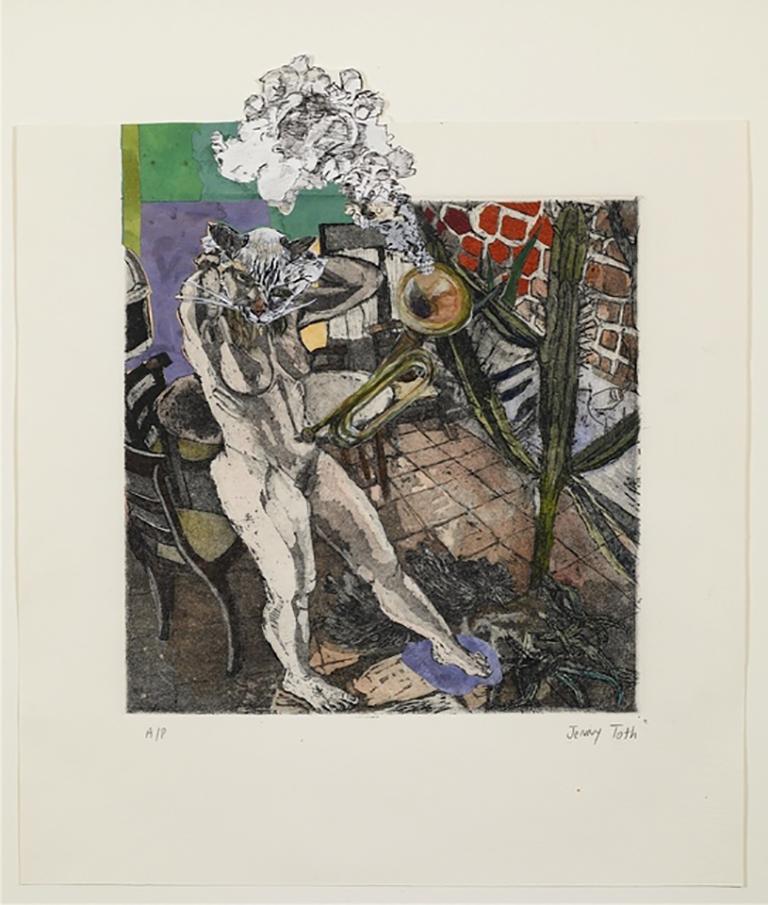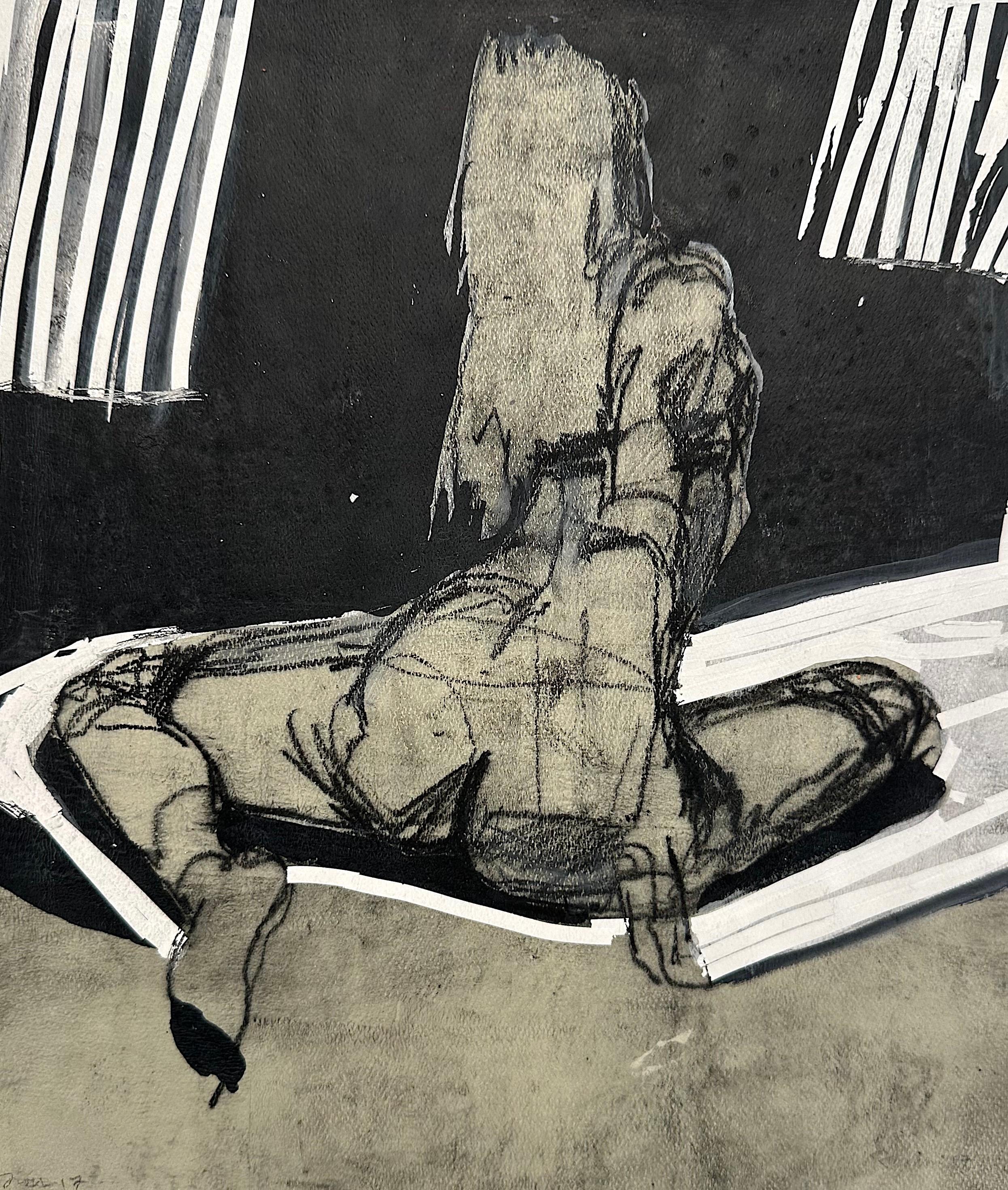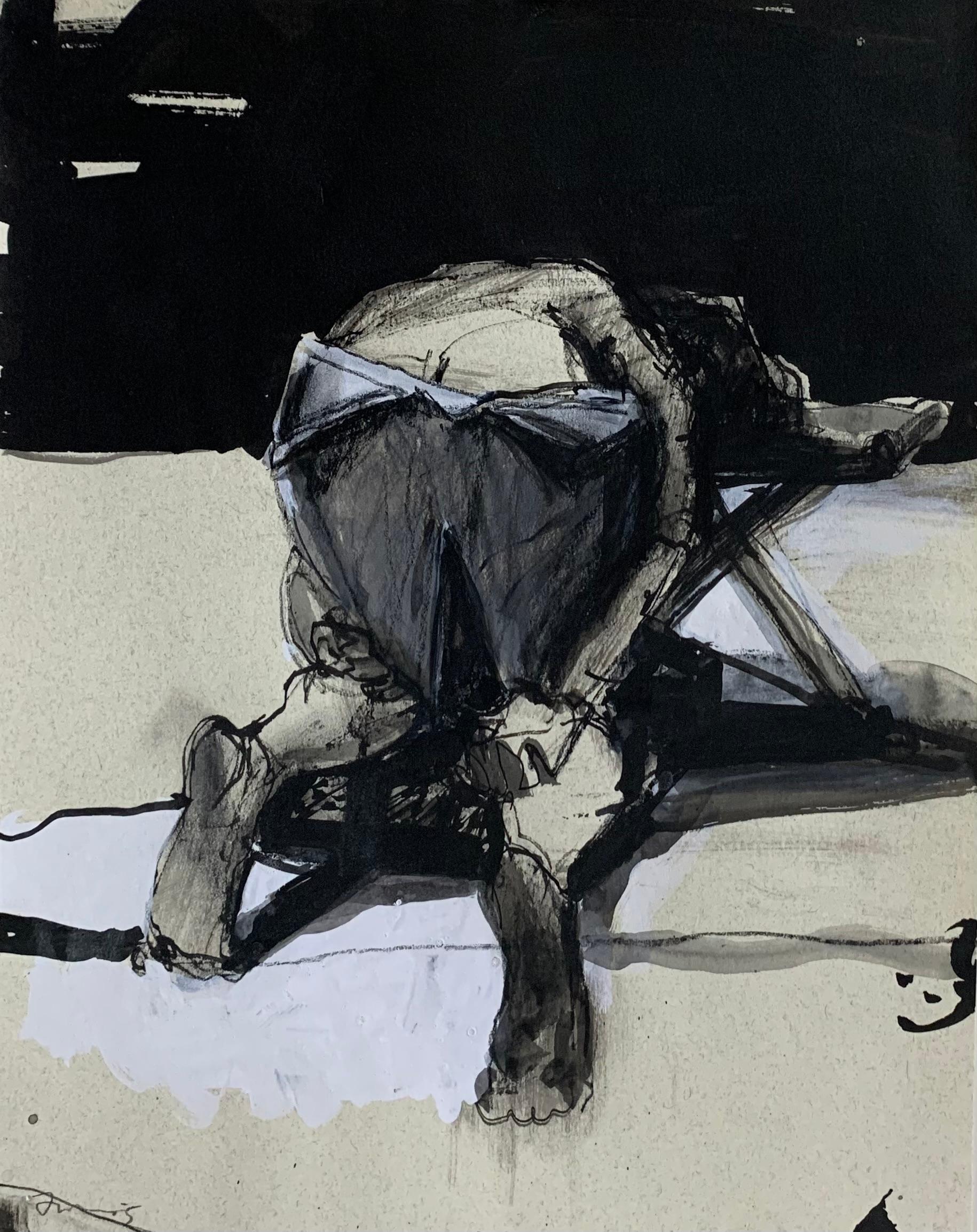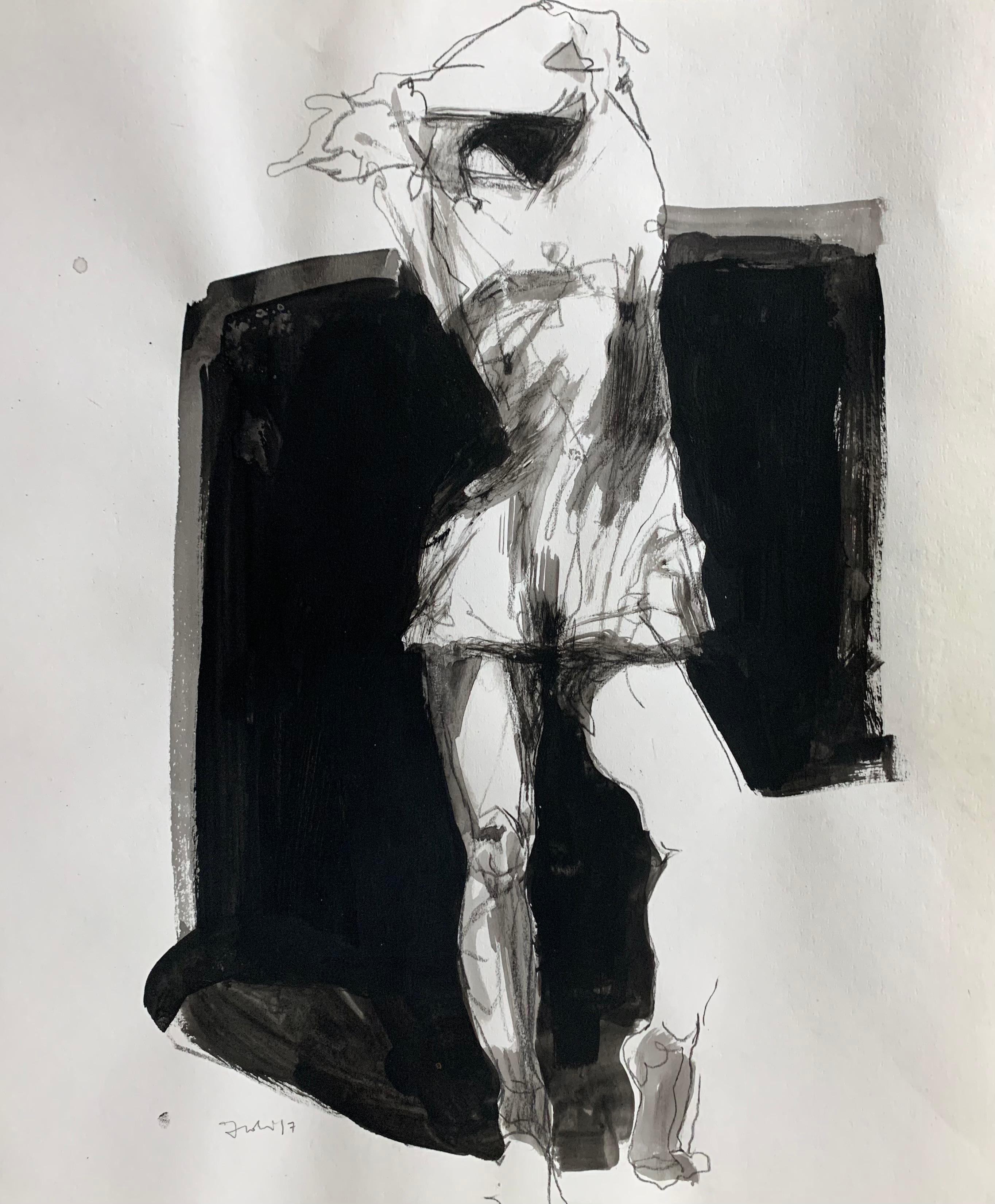Want more images or videos?
Request additional images or videos from the seller
1 of 2
Jessica HoustonTaking Place2022
2022
About the Item
A group of figures heads for icy distant mountains. A familiar enough scene of polar explorers hauling their sledges. Yet somehow this does not quite fit the heroic mold. The ice and sky are tinged a movie musical pale blue and their gear is a bit too colorful for the era of man-hauling. And then there’s the sled, piled high not with boxes of supplies but with a jumbled heap of antiquities: Greek Athenas, bits of a coliseum, a ship’s great wheel. In Jessica Houston’s collage “The Long Haul,” the explorers drag history itself into the great beyond, their backs turned from their absurd load. But we take in the entire scene.
In her suite of works, Over the Edge of the World, Houston uses oil on wood, ink on paper, and collages of found images, many from National Geographic Magazine, to rearrange the evidence – and thus history’s possibilities.
Houston joins visual artists such as Judit Hersko, Katja Aglert, and Isaac Julien who have been inspired by the explorers of the past. Like them, she draws, in part, on the singular tradition of polar exploration narratives as well as fictions such as Ursula Le Guin’s “Sur” (1981), a utopian feminist hoax in which a party of South American women reach the South Pole in 1909, two years before the official arrival of European explorers. Le Guin’s explorers do not feel compelled to leave any written record or physical proof of their presence at the South Pole. If Le Guin’s women might have made it, what other traces have been missed?
Collage can work alongside alternative history: it interprets, interrupts, and rearranges. It questions the completed whole, instead emphasizing composition and relation. Collage suggests it all might be … otherwise. Houston’s collages flaunt their second nature. Yet what they show remains somehow plausible. You want to believe what you’re beginning to see.
In “A life Attuned to Larger Rhythms” Houston grids out rectangles of captured images to overwhelm the eye as the polar environment itself might (whiteout is a paradoxical species of optical overstimulation). Through the strangely ordered confusion of an ice survey grafted atop a chessboard, the mind begins to recognize new connections, emergent shapes: a different future? In “Launching Strategy” a yellow-orange pyramid balances garishly atop a tent. Which came first, the realist tent or the Platonic shape? Can we ever be sure that we’re not already seeing through premade abstractions? Or is it that baggage we’ve been dragging along?
In “Architecture of the Anthropocene” and “Red Blood, Red Earth” Houston reroutes visually symbolic through-lines between women and non-European people and the official history in which they appear dimly or not at all. A full-skirted woman holds onto the tether of a kite that seems to pull her upwards towards a weather balloon floating above an Antarctic base’s radio tower; a row of tropical workers wielding pickaxes folds into the trajectory of a sailor aiming a bow and arrow at an iceberg stained with red. These are not people or images normally associated with polar discovery. But shouldn’t they matter?
“Territory Over Land” strips in a scene from a painted depiction of the tropics, possibly from one of Captain James Cook’s circumnavigations. “Captain Cook’s Legacy” more directly confronts an official portrait of Cook with the torn-in eyes from what can only be described as the explorer’s anonymous dark Other. The hybrid portrait is a kind of contact zone. “Henson and Peary – Past Entanglements” is a cooler, less volatile twin portrait of disputed discoverer of the North Pole Robert Peary and his African-American second in command, Mathew Henson, who was consistently erroneously referred to as Peary’s “manservant.”
Houston re-mystifies polar landscapes that have become through tourism and even the most well-meaning nature documentaries too familiar, too smooth and clean, replete with aesthetically pleasing icebergs and bright icescapes under perfect blue skies. But the poles have 6 months of darkness too. Houston deepens and complicates received images, but without reviving heroic dramas of survival against a blank, enemy ice. The ice in the “Sur” paintings is grimy, oily, swirling with evocations of masted ships swallowed up in dark seas. History is a risk. Survival is not guaranteed.
- Creator:Jessica Houston (1970, American)
- Creation Year:2022
- Dimensions:Height: 10 in (25.4 cm)Width: 14 in (35.56 cm)
- Medium:
- Movement & Style:
- Period:
- Condition:
- Gallery Location:Montreal, CA
- Reference Number:1stDibs: LU47610875872
Jessica Houston
Jessica Houston (MA, Columbia University) has traveled from pole to pole, using color and light to entangle and provoke questions related to our changing natural world, and our nature within it. She has created site-specific works for the NJ MOCA (NJ); the Castello di Corigliano (Puglia, Italy); and The Albany Airport (Albany, NY). Select exhibitions include Art Mûr Gallery, Montréal, Canada; The Hyde Collection Museum, Glens Falls, NY; and The Latimer House Museum, New York, NY. She has been invited to residencies at The Albers Foundation and CAMAC Center for Art, Science and Technology in France. Her works are funded by The Canada Council for the Arts and are in the collections of La collection Prêt d’œuvres d’art, Musée National Des Beaux-Arts du Quebec; Bibliothèque et Archives nationales du Québec (BAnQ), Montréal, Québec; Bank of Montréal, Toronto; and the Consulate General of Monaco, Montréal. She has lectured at The Art Institute of Florence; Columbia University; Concordia University; and OCAD University.
About the Seller
5.0
Vetted Seller
These experienced sellers undergo a comprehensive evaluation by our team of in-house experts.
Established in 1996
1stDibs seller since 2014
96 sales on 1stDibs
- ShippingRetrieving quote...Ships From: Montreal, Canada
- Return PolicyA return for this item may be initiated within 7 days of delivery.
More From This SellerView All
- Drawing in WaterBy Jessica HoustonLocated in Montreal, QuebecA group of figures heads for icy distant mountains. A familiar enough scene of polar explorers hauling their sledges. Yet somehow this does not quite fit the heroic mold. The ice and sky are tinged a movie musical pale blue and their gear is a bit too colorful for the era of man-hauling. And then there’s the sled, piled high not with boxes of supplies but with a jumbled heap of antiquities: Greek Athenas, bits of a coliseum, a ship’s great wheel. In Jessica Houston’s collage “The Long Haul,” the explorers drag history itself into the great beyond, their backs turned from their absurd load. But we take in the entire scene. In her suite of works, Over the Edge of the World, Houston uses oil on wood, ink on paper, and collages of found images, many from National Geographic Magazine, to rearrange the evidence – and thus history’s possibilities. Houston joins visual artists such as Judit Hersko, Katja Aglert, and Isaac Julien who have been inspired by the explorers of the past. Like them, she draws, in part, on the singular tradition of polar exploration narratives as well as fictions such as Ursula Le Guin’s “Sur” (1981), a utopian feminist hoax in which a party of South American women reach the South Pole in 1909, two years before the official arrival of European explorers. Le Guin’s explorers do not feel compelled to leave any written record or physical proof of their presence at the South Pole. If Le Guin’s women might have made it, what other traces have been missed? Collage can work alongside alternative history: it interprets, interrupts, and rearranges. It questions the completed whole, instead emphasizing composition and relation. Collage suggests it all might be … otherwise. Houston’s collages flaunt their second nature. Yet what they show remains somehow plausible. You want to believe what you’re beginning to see. In “A life Attuned to Larger Rhythms” Houston grids out rectangles of captured images to overwhelm the eye as the polar environment itself might (whiteout is a paradoxical species of optical overstimulation). Through the strangely ordered confusion of an ice survey grafted atop a chessboard, the mind begins to recognize new connections, emergent shapes: a different future? In “Launching Strategy” a yellow-orange pyramid balances garishly atop a tent. Which came first, the realist tent or the Platonic shape? Can we ever be sure that we’re not already seeing through premade abstractions? Or is it that baggage we’ve been dragging along? In “Architecture of the Anthropocene” and “Red Blood, Red Earth” Houston reroutes visually symbolic through-lines between women and non-European people and the official history in which they appear dimly or not at all. A full-skirted woman holds onto the tether of a kite that seems to pull her upwards towards a weather balloon floating above an Antarctic base’s radio tower; a row of tropical workers wielding pickaxes folds into the trajectory of a sailor aiming a bow and arrow at an iceberg stained with red. These are not people or images normally associated with polar discovery. But shouldn’t they matter? “Territory Over Land” strips in a scene from a painted depiction of the tropics, possibly from one of Captain James Cook’s circumnavigations. “Captain Cook’s Legacy” more directly confronts an official portrait of Cook with the torn-in eyes from what can only be described as the explorer’s anonymous dark Other. The hybrid portrait is a kind of contact zone. “Henson and Peary – Past Entanglements” is a cooler, less volatile twin portrait of disputed discoverer of the North Pole Robert Peary...Category
2010s Contemporary Mixed Media
MaterialsInk, Archival Paper
- FootprintsBy Jessica HoustonLocated in Montreal, QuebecA group of figures heads for icy distant mountains. A familiar enough scene of polar explorers hauling their sledges. Yet somehow this does not quite fit the heroic mold. The ice and...Category
2010s Contemporary Mixed Media
MaterialsInk, Archival Paper
- The Fatigue of the ConquestBy Jessica HoustonLocated in Montreal, QuebecA group of figures heads for icy distant mountains. A familiar enough scene of polar explorers hauling their sledges. Yet somehow this does not quite fit the heroic mold. The ice and sky are tinged a movie musical pale blue and their gear is a bit too colorful for the era of man-hauling. And then there’s the sled, piled high not with boxes of supplies but with a jumbled heap of antiquities: Greek Athenas, bits of a coliseum, a ship’s great wheel. In Jessica Houston’s collage “The Long Haul,” the explorers drag history itself into the great beyond, their backs turned from their absurd load. But we take in the entire scene. In her suite of works, Over the Edge of the World, Houston uses oil on wood, ink on paper, and collages of found images, many from National Geographic Magazine, to rearrange the evidence – and thus history’s possibilities. Houston joins visual artists such as Judit Hersko, Katja Aglert, and Isaac Julien who have been inspired by the explorers of the past. Like them, she draws, in part, on the singular tradition of polar exploration narratives as well as fictions such as Ursula Le Guin’s “Sur” (1981), a utopian feminist hoax in which a party of South American women reach the South Pole in 1909, two years before the official arrival of European explorers. Le Guin’s explorers do not feel compelled to leave any written record or physical proof of their presence at the South Pole. If Le Guin’s women might have made it, what other traces have been missed? Collage can work alongside alternative history: it interprets, interrupts, and rearranges. It questions the completed whole, instead emphasizing composition and relation. Collage suggests it all might be … otherwise. Houston’s collages flaunt their second nature. Yet what they show remains somehow plausible. You want to believe what you’re beginning to see. In “A life Attuned to Larger Rhythms” Houston grids out rectangles of captured images to overwhelm the eye as the polar environment itself might (whiteout is a paradoxical species of optical overstimulation). Through the strangely ordered confusion of an ice survey grafted atop a chessboard, the mind begins to recognize new connections, emergent shapes: a different future? In “Launching Strategy” a yellow-orange pyramid balances garishly atop a tent. Which came first, the realist tent or the Platonic shape? Can we ever be sure that we’re not already seeing through premade abstractions? Or is it that baggage we’ve been dragging along? In “Architecture of the Anthropocene” and “Red Blood, Red Earth” Houston reroutes visually symbolic through-lines between women and non-European people and the official history in which they appear dimly or not at all. A full-skirted woman holds onto the tether of a kite that seems to pull her upwards towards a weather balloon floating above an Antarctic base’s radio tower; a row of tropical workers wielding pickaxes folds into the trajectory of a sailor aiming a bow and arrow at an iceberg stained with red. These are not people or images normally associated with polar discovery. But shouldn’t they matter? “Territory Over Land” strips in a scene from a painted depiction of the tropics, possibly from one of Captain James Cook’s circumnavigations. “Captain Cook’s Legacy” more directly confronts an official portrait of Cook with the torn-in eyes from what can only be described as the explorer’s anonymous dark Other. The hybrid portrait is a kind of contact zone. “Henson and Peary – Past Entanglements” is a cooler, less volatile twin portrait of disputed discoverer of the North Pole Robert Peary...Category
2010s Contemporary Mixed Media
MaterialsInk, Archival Paper
- Landline #2By Sonny AssuLocated in Montreal, QuebecThey make magic lines on the land that only they can see. - A Hupacasath man’s response to early colonial surveyors demarcating the boundaries of his reserve. Sonny Assu’s childho...Category
2010s Contemporary Figurative Drawings and Watercolors
MaterialsArchival Paper, Ink
- Landline #14By Sonny AssuLocated in Montreal, QuebecThey make magic lines on the land that only they can see. - A Hupacasath man’s response to early colonial surveyors demarcating the boundaries of his reserve. Sonny Assu’s childho...Category
2010s Contemporary Figurative Drawings and Watercolors
MaterialsInk, Archival Paper
- Landline #10By Sonny AssuLocated in Montreal, QuebecThey make magic lines on the land that only they can see. - A Hupacasath man’s response to early colonial surveyors demarcating the boundaries of his reserve. Sonny Assu’s childho...Category
2010s Contemporary Figurative Drawings and Watercolors
MaterialsInk, Archival Paper
You May Also Like
- Untitled _ ''White Inferno'' series.Located in T'bilisi, GEThe "White Inferno" series features crafted mixed media artworks, blending diverse mediums to create intense visual compositions. Incorporating collage p...Category
21st Century and Contemporary Contemporary Mixed Media
MaterialsPencil, Paint, Charcoal, Ink, Mixed Media, Oil, Spray Paint, Acrylic, Ar...
- Shutting Out Self Doubt, hand tinted etching of cat woman nude, music instrumentBy Jenny TothLocated in Brooklyn, NYAquatint and watercolor collage by Jenny Toth, mixed media artist, professor, graduate of Yale School of ArtCategory
2010s Contemporary Mixed Media
MaterialsWatercolor, Aquatint, Archival Ink, Archival Paper, Etching
- Marie ReachesBy Kim FrohsinLocated in Burlingame, CAKim Frohsin, Third generation Bay Area Figurative artist began exhibiting in the San Francisco Bay Area in the early 1990s, and in 1993 was...Category
21st Century and Contemporary Contemporary Nude Drawings and Watercolors
MaterialsInk, Archival Paper, Pencil
- La RaccourcieBy Kim FrohsinLocated in Burlingame, CAKim Frohsin, Third generation Bay Area Figurative artist began exhibiting in the San Francisco Bay Area in the early 1990s, and in 1993 was...Category
21st Century and Contemporary Contemporary Nude Drawings and Watercolors
MaterialsInk, Archival Paper, Pencil
- Sahar SilhouetteBy Kim FrohsinLocated in Burlingame, CAKim Frohsin, Third generation Bay Area Figurative artist began exhibiting in the San Francisco Bay Area in the early 1990s, and in 1993 was...Category
21st Century and Contemporary Contemporary Nude Drawings and Watercolors
MaterialsInk, Archival Paper, Pencil
- Marya DisrobesBy Kim FrohsinLocated in Burlingame, CAKim Frohsin, Third generation Bay Area Figurative artist began exhibiting in the San Francisco Bay Area in the early 1990s, and in 1993 was included with Nathan Olivera, Manuel Neri and Stephen De...Category
21st Century and Contemporary Contemporary Nude Drawings and Watercolors
MaterialsArchival Paper, Pencil, Ink






